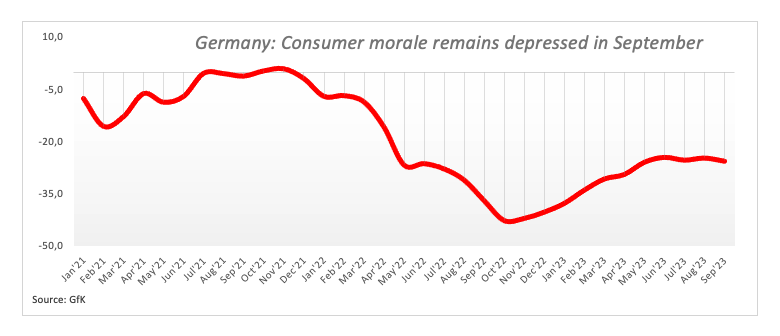Euro treads water near 1.0800 ahead of US data releases

- The Euro remains directionless just above 1.0800 against the US Dollar.
- Stocks in Europe maintain the weekly rebound well in place.
- The USD Index (DXY) orbits around the 104.00 zone.
- US, German yields kick slip back to the negative territory.
- Consumer Confidence in Germany weakens in September.
Price action around the Euro (EUR) appears inconclusive against the US Dollar (USD), motivating EUR/USD to hover around the 1.0800 neighbourhood so far on Tuesday.
The Greenback also exchanges ups and downs around the 104.00 region when tracked by the USD Index (DXY). Meanwhile, US yields show renewed weakness amidst speculation of the Federal Reserve (Fed) pausing its interest-rate hiking cycle at the September meeting and opting for a quarter-point rate hike in November.
Looking at the broader picture, there is a renewed discourse regarding monetary policy, specifically the Fed’s dedication to maintaining a more stringent approach for a prolonged period. This heightened attention stems from the remarkable resilience exhibited by the US economy, even in the face of a slight easing in the job market and declining inflation figures observed in recent months.
Across the pond, internal conflicts among members of the European Central Bank (ECB) governing council are emerging regarding the possibility of extending the restrictive policy stance beyond the summer season. These differences of opinion are contributing to persistent uncertainty around the central bank and act as a source of potential weakness for the single currency.
On the domestic data space, Consumer Confidence in Germany worsened to -25.5 when tracked by GfK for the month of September, while Consumer Confidence in France held steady at 85 in August.
In the US, the Conference Board will publish its Consumer Confidence measure along with the FHFA House Price Index and JOLTS Job Openings.
Daily digest market movers: Euro looks for direction around 1.0800
- The Euro gyrates around the 1.0800 zone against the USD.
- German, US bond yields lose further momentum on Tuesday.
- The US labour market, inflation figures take centre stage this week.
- Japanese jobless rate ticked higher in July.
- Fed’s tighter-for-longer narrative keeps running in the background.
- The probability of a Fed’s 25 bps rate raise in November hovers around 50%.
Technical Analysis: Euro remains well under pressure and risks extra losses
EUR/USD is battling to keep the trade above the key 1.0800 hurdle in quite an apathetic trading session on Tuesday.
Further declines could motivate EUR/USD to revisit Friday’s low of 1.0765, ahead of the May 31 low of 1.0635 and the March 15 low of 1.0516. The loss of this level could prompt a test of the 2023 low at 1.0481 seen on January 6 to reemerge.
Occasional bouts of strength should meet provisional resistance at the 55-day Simple Moving Average (SMA) at 1.0965, prior to the psychological 1.1000 barrier and the August 10 high at 1.1064. Once the latter is cleared, spot could challenge 1.1149 from July 27. If the pair surpasses this region, it could alleviate some of the downward pressure and potentially visit the 2023 peak of 1.1275 seen on July 18. Further up comes the 2022 high at 1.1495, which is closely followed by the round level of 1.1500.
Furthermore, sustained losses are likely in EUR/USD once the 200-day SMA (1.0807) is breached in a convincing fashion.
ECB FAQs
The European Central Bank (ECB) in Frankfurt, Germany, is the reserve bank for the Eurozone. The ECB sets interest rates and manages monetary policy for the region.
The ECB primary mandate is to maintain price stability, which means keeping inflation at around 2%. Its primary tool for achieving this is by raising or lowering interest rates. Relatively high interest rates will usually result in a stronger Euro and vice versa.
The ECB Governing Council makes monetary policy decisions at meetings held eight times a year. Decisions are made by heads of the Eurozone national banks and six permanent members, including the President of the ECB, Christine Lagarde.
In extreme situations, the European Central Bank can enact a policy tool called Quantitative Easing. QE is the process by which the ECB prints Euros and uses them to buy assets – usually government or corporate bonds – from banks and other financial institutions. QE usually results in a weaker Euro.
QE is a last resort when simply lowering interest rates is unlikely to achieve the objective of price stability. The ECB used it during the Great Financial Crisis in 2009-11, in 2015 when inflation remained stubbornly low, as well as during the covid pandemic.
Quantitative tightening (QT) is the reverse of QE. It is undertaken after QE when an economic recovery is underway and inflation starts rising. Whilst in QE the European Central Bank (ECB) purchases government and corporate bonds from financial institutions to provide them with liquidity, in QT the ECB stops buying more bonds, and stops reinvesting the principal maturing on the bonds it already holds. It is usually positive (or bullish) for the Euro.
